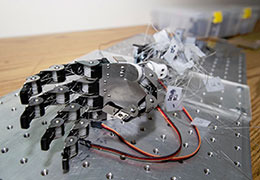Idaho State University engineering, physical therapy researchers join effort to create an augmented reality device to aid arm rehabilitation

ISU researchers are teaming up to create what they call an "augmented reality device" to help people who have suffered from strokes or who have had an arm amputation.
They are in the process of creating wearable goggles using a virtual reality system that could potentially even help patients before they have a new prosthetic after an amputation, or have use of their arms after a stroke.
"The patients can wear a set of goggles that will give them a virtual image of the arm they use or have trouble moving either due to a stroke that hasn't recovered well or because of an amputation," said Nancy Devine, ISU physical therapy associate dean and director. "The device will help teach them through a virtual-reality system to use their limb or prosthetic device."
At ISU, Devine is working with Alba Perez Gracia, associate chair and associate professor of mechanical engineering and Marco Schoen, mechanical engineering professor.
"There is evidence that watching a real or virtual human arm motion improves arm control by the observer," said Perez Gracia. "This project aims to develop and test a new, virtual-reality, wearable system for training of the human arm."
For this project, the ISU researchers are working on a National Science Foundation Grant in collaboration with Texas A&M University and California State Fullerton University to develop the new device for upper-limb rehabilitation.
The ISU researchers will work on some of the robotics, control and patient training protocol aspects of the project. Training protocols will be developed to aid rehabilitation of patients following stroke or upper limb amputations.
The anticipated outcome of the three-year "very conceptual" project is to have a showcase demonstration and have a sample device. The goal of the first year is to develop the device, the goal of the second year is to implement it with people who have had strokes, and the goal of the third year is to implement it with people who have had amputations.
ISU mechanical engineering's role in the project is the robotic mapping of the motion to the human hand and the identification of body signals related to the motion intention.
"We have to simulate the motion of a human hand and make it move the virtual model with different nerve signals," Perez Gracia said. "We have to map the simple nerve signals into the motion of the whole human hand that is realistic."
Devine will be helping with the implementation of the device and testing rehabilitation protocols.
ISU and its partners received the grant through the NSF's General and Age Related Disabilities Engineering (GARDE) program, which supports fundamental engineering research that will lead to the development of new technologies, devices, or software for persons with disabilities. The grant's official title is "Collaborative Research - Augmented Perception for Upper-Limb Rehabilitation." ISU is receiving about $152,000 for its share of the grant.
